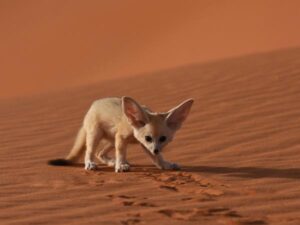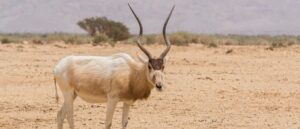Introduction
Evoking images of endless golden hills, rugged terrain and intense heat, the Sahara is far from lifeless. Indeed, it is filled with wildlife groups that are uniquely adapted to thrive in this seemingly inhospitable environment. Every creature, from the tiniest insect to the most exotic mammal, can cope with the extreme heat and water scarcity of the desert by developing intelligent survival strategies
The dangers of the Sahara desert
But this iconic picture of wilderness life is in grave danger. A number of Saharan species find their lives hanging on the edge of increasing uncertainty. Human activities such as illegal hunting, habitat destruction and climate change are the main causes of this problem
Let’s delve into the vibrant ecosystem of the Sahara and join as we raise our voices for the wildlife that bravely fights for survival in the face of relentless suffering.
Importance of Sahara Desert wildlife
Ecological role of Saharan Desert wildlife
The Sahara Desert is not just a stretch of sand; It preserves the complex and fragile ecosystems necessary to balance life on this complex earth. Each species, regardless of size, plays an important role in maintaining the balance of grassland ecosystems. Many plants and animals interact with each other, allowing both to survive and thrive. These relationships are essential to the stability of ecosystems, and every species relies on each other to maintain balance, from top predators to small insects
Unique adaptation of desert species
Sahara Desert wildlife has adapted to the region’s extreme rainfall and temperatures. These changes are a testament to life’s incredible flexibility and intelligence, even in the face of seemingly insurmountable challenges:
- Camouflage: Many desert species boast a unique ability to blend seamlessly into their surroundings, hiding from predators or waiting for unsuspecting prey to arrest them.
- Night: To escape the scorching heat of the day, Saharans have adopted a nocturnal lifestyle, doing most of their work in the cool cover of night
- Water conservation: Desert animals have evolved specific strategies to conserve water, such as excreting large amounts of water or never sweating, thereby reducing unforgiving water loss to the elements in.
- Temperature regulation: Being able to regulate body temperature is very important where temperatures can fluctuate dramatically between night and day. Different species have developed unique strategies
The role of human activities in threatening species
Climate change and its effects
As climate change increases global temperatures, the Sahara Desert expands, continuing to encroach on nearby habitats. This expansion not only reduces the viable territory available to displaced species, but also increases the struggle for survival in the grassland ecosystem Furthermore, fluctuations in temperature and rainfall can lead to infrastructure degradation and disruption of the reproductive cycle, further endangering Saharan wildlife
A comprehensive study of seven endangered species
-
Addax (Addax nasomaculatus) .
Description and special features
Commonly known as the ‘White Deer’, the Addax is the only critically endangered species in the Sahara to live in the desert. Known for their blue reflective coats, they have adapted to desert environments. Their broad, wide toes keep them out of the soft sand, while the long, twisted horns act as an effective cooling mechanism thanks to the blood vessels close to the skin.
threat and security environment
Addaxs face serious threats from unregulated hunting, competition with animals, and habitat destruction due to oil exploration. Once widespread in the Sahara, the species is now listed as “critically endangered” on the IUCN Red List with fewer than 100 individuals left in the wild.
-
Ghazal Dama (Nanger dama)
Description and special features
The Dama elephant or Mhor elephant is another noble species of the Sahara. These magnificent elephants boast slender lengths and incredible light and dark coats. Stealthy and agile, they are well equipped for life in the desert, their water needs coming mainly from food and dew.
threat and security environment
Poaching, habitat loss due to agriculture and competition with domestic animals has led to a dramatic decline in the Dama Gazelle population and wildlife groups consider the species to be among the most endangered antelopes in the world. The Dama gazelle is currently listed as “Critically Endangered” on the IUCN Red List.
-
Sahara Deer (Acinonyx jubatus hecki) .
Description and special features
Recognized for its unique coat and small stature, the Saharan cheetah, also known as the Northwest African cheetah, holds a special place in the Saharan wild Their soft coat provides an advantage over desert cover, while their small body ensuring minimal energy consumption – with adaptations necessary to survive in this harsh ecosystem
threat and security environment
Like Addax, the Dana leopard, the Saharan cheetah faces severe threats from poaching, habitat loss and conflict with local communities. Currently listed as “critically endangered” on the IUCN Red List, their population in the wild is estimated to be less than 250 mature individuals.
-
Desert Guard (Varanus griseus) .
Description and special features
The desert monitor, one of the largest reptiles in the Sahara Desert, is fascinating. It is characterized by a strong, elongated body and a powerful jaw. An effective predator, he has sharp claw teeth for hunting and a forked tongue for detecting delicate chemicals.
threat and security environment
The species is listed as “threatened” on the IUCN Red List. It poses a threat due to habitat loss resulting from agricultural expansion and hunting. Their fur is expensive and is often leased for the pet trade business.
-
Barbary Macaque (Macaca sylvanus) .
Description and special features
The Barbary Macaque is unique in that it is the only macaque species found outside of Asia, its preferred habitats in the foothills of the Atlas and Rif Mountains that have a thick fur coat that can withstand their cold climate, and which uniquely, both male and female Barbary Macaques are involved in rearing young
threat and security environment
Despite being a protected species in all countries in which it lives, the Barbary Macaque is listed as “Endangered” on the IUCN Red List due to habitat loss, hunting and capture for the illegal pet trade People numbers continue to decline.
-
North African elephant shrew (Elephantulus rozeti) .
Description and special features
This small mammal gets its name from its long, stick-like snout. Fast and agile, it uses its spring-like hind legs to evade predators with quick, erratic jumps, known to eat invertebrates, insects in particular
threat and security environment
Although little is known about the exact status of the North African elephant shrew, its population is declining due to habitat destruction. The IUCN lists the species as “Least Concern,” but it is important to manage because of potential threats.
-
Saharan silver spider (Cataglyphis bombycina) .
Description and special features
Saharan silver beetles, known for their stunning silvery coat, have evolved to survive in the hot desert temperatures. Their silver coat reflects sunlight and warmth, helping them to withstand the hot sun. Notably, they can adjust their speed based on kick frequency to optimize travel.
threat and security environment
The threat status of these moths is not well understood, but general habitat loss and climate change pose potential threats. Like many insect species, conservation has not been well studied, emphasizing the need for further research.
conservation efforts and the role of international organizations
The Sahara Desert faces threats from numerous endangered species prompting focused conservation efforts. Several international and local organizations are critical to these efforts.
Old conservation efforts
Several conservation measures are already underway throughout the Sahara region. These include:
- Sanctuaries and protected areas: Many wildlife sanctuaries and protected areas have been established to provide safe habitat for endangered species. These areas reduce risks such as habitat loss and generally have laws against hunting.
- Monitoring and assessment: Regular monitoring and monitoring helps monitor species population trends, understand threats and develop appropriate conservation strategies.
- Human-wildlife conflict reduction: Efforts are being made to manage and reduce human-wildlife conflict, especially in areas where communities live near wildlife habitats
Ways the general public can help
There are many ways individuals can contribute to the survival and conservation of endangered Saharan wildlife:
- Support for conservation organizations: Contributions from conservation organizations provide important funding.
- Educate yourself and others: Learning about these endangered species and promoting awareness increases understanding and stimulates action.
- Responsible tourism: When visiting the Sahara or other fragile ecosystems, respect local customs and guidelines, avoid harming or disturbing wildlife, and avoid buying products made from endangered species has been done.
conclusion
Once teeming with biodiversity, the Sahara Desert now faces alarming numbers of endangered species. The threats to Saharan wildlife, from poaching to habitat loss, are devastating and require effective, immediate response. Despite conservation efforts, the role of communities, individuals and international organizations is still needed to preserve and restore desert natural wonders. Endangered species such as Addax, Dama Gazelle, Sahara Cheetah, Desert Monitor, Barbary Macaque, North African Elephant Shrew and Sahara Silver Ant As a reminder It is our collective responsibility to ensure the success of these viable species in future generations.








